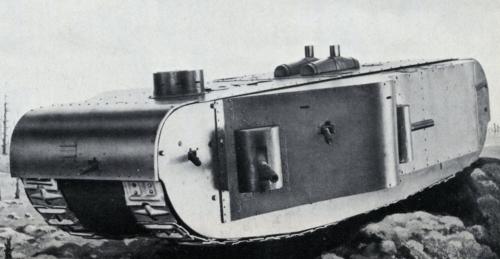
Super heavy tank K-Wagen
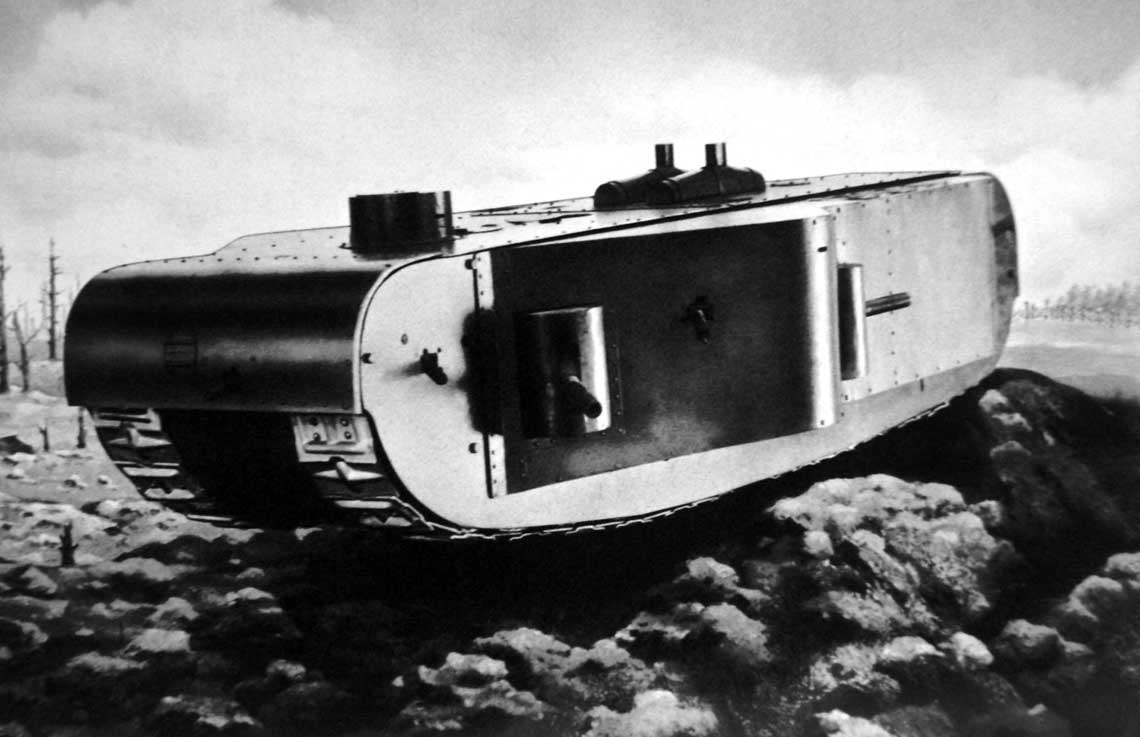
Model tank K-Wagen, front view. The dome of the tower of two artillery observers is visible on the ceiling, further exhaust pipes from two engines.
It would seem that the era of large and very heavy tanks in history coincided with the period of the Second World War - then in the Third Reich, projects were developed for a number of combat tracked vehicles weighing more than a hundred tons or more, and some were even implemented (E-100, Maus, etc. .d.). However, it is often overlooked that the Germans began working on tanks with these characteristics during the Great War, shortly after the debut of this new type of weapon on the battlefield on the Allied side. The end result of the engineering effort was the K-Wagen, the largest and heaviest tank of the First World War.
When the Germans first encountered tanks on the Western Front in September 1916, the new weapon evoked two opposing feelings: horror and admiration. It would seem that the unstoppable machines seemed to the imperial soldiers and commanders who fought on the front lines as a formidable weapon, although at first the German press and some senior officers reacted rather dismissively to the invention. However, the unjustified, disrespectful attitude was quickly replaced by a real calculation and a sober assessment of the potential of tracked combat vehicles, which led to the emergence of interest from the German High Command of the Ground Forces (Oberste Heersleitung - OHL). who wanted to have the equivalent of the British military in his arsenal. Help him tip the scales of victory in his favor.
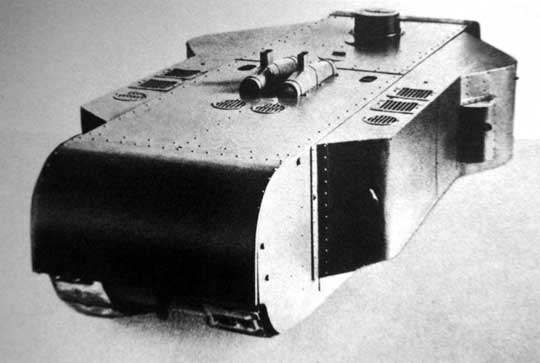
Model K-Wagen, this time from behind.
The German efforts to create the first tanks basically ended (not counting the designs of carts left on the drawing boards) with the construction of two vehicles: the A7V and the Leichter Kampfwagen versions I, II and III (some historians and military enthusiasts say that the development of the LK III stopped at the design stage) . The first machine - slow-moving, not very maneuverable, produced in the amount of only twenty copies - managed to enter service and take part in hostilities, but general dissatisfaction with its design led to the fact that the development of the machine was abandoned forever in February 1918. More promising, even due to the best characteristics, although not without flaws, an experimental design remained. The inability to provide the hastily created German armored forces with domestically produced tanks meant the need to supply their ranks with captured equipment. The soldiers of the imperial army intensively "hunted" for the vehicles of the allies, but without much success. The first serviceable tank (Mk IV) was captured only on the morning of November 24, 1917 in Fontaine-Notre-Dame after an operation carried out by a group led by corporal (non-commissioned officer) Fritz Leu from Armee Kraftwagen Park 2 (of course, before this date, the Germans managed to get a certain number of British tanks, but they were damaged or damaged so much that they were not subject to repair and combat use). After the end of the fighting for Cambrai, seventy-one more British tanks in various technical conditions fell into the hands of the Germans, although the damage to thirty of them was so superficial that their repair was not a problem. Soon the number of captured British vehicles reached such a level that they managed to organize and equip several tank battalions, which were then used in battle.
In addition to the tanks mentioned above, the Germans also managed to complete approximately 85-90% of two copies of the K-Wagen (Colossal-Wagen) tank weighing about 150 tons (another common name, for example, Grosskampfwagen), which was unmatched in size and weight before the Second World War.

Model K-Wagen, right side view with side nacelle installed.

Model K-Wagen, right side view with side nacelle disassembled.
The history of the title tank is perhaps the most mysterious of all that were associated with German tracked combat vehicles during the First World War. While the genealogies of vehicles such as the A7V, LK II/II/III or even the never-built Sturm-Panzerwagen Oberschlesien can be traced relatively accurately thanks to surviving archival material and a number of valuable publications, in the case of the structure we are interested, it is difficult . It is assumed that the order for the design of the K-Wagen was placed by OHL on March 31, 1917 by specialists from the military department of the 7th Department of Transport (Abteilung 7. Verkehrswesen). The formulated tactical and technical requirements assumed that the designed vehicle would receive armor from 10 to 30 mm thick, be able to overcome ditches up to 4 m wide, and its main armament should consist of one or two SK / L. 50 guns, and defensive armament was to consist of four machine guns. In addition, the possibility of placing flamethrowers "on board" was left up for consideration. It was planned that the specific gravity of the pressure exerted on the ground would be 0,5 kg / cm2, the drive would be carried out by two engines of 200 hp each, and the gearbox would provide three gears forward and one reverse. According to forecasts, the crew of the car was supposed to be 18 people, and the mass should fluctuate around 100 tons. The cost of one car was estimated at 500 marks, which was an astronomical price, especially considering the fact that one LK II cost in the region of 000–65 marks. When listing the problems that could arise as a result of the need to transport the car over a longer distance, the use of a modular design was assumed - although the number of independent structural elements was not specified, it was required that each of them should weigh no more than 000 tons. The terms of reference seemed so absurd to the War Ministry (Kriegsministerium) that it initially refrained from expressing support for the idea of \u70b\u000bbuilding a car, but quickly changed its mind in connection with the news of the growing success of Allied armored vehicles. cars from the front.
The performance characteristics of the machine, at that time unusual and unprecedented at that time, gushing with megalomania, now raise a logical question about its purpose. At present, it is widely believed, perhaps by analogy with the projects of the R.1000 / 1500 land cruisers of the Second World War, that the Germans intended to use the K-Vagens as "mobile fortresses", directing them to act on the most dangerous areas front. From a logical point of view, this point of view seems correct, but the subjects of Emperor Wilhelm II seem to have seen them as an offensive weapon. At least to some extent, this thesis is confirmed by the fact that in the summer of 1918 the name Sturmkraftwagen schwerster Bauart (K-Wagen) was used for the tachanka at least once, which clearly indicates that it was not considered as a purely defensive weapon.
Despite their best wishes, the staff of Abteilung 7. Verkehrswesen had no experience in designing a tank commissioned by OHL, so the department's leadership decided to "hire" an outsider for this purpose. In the literature, especially in the older one, there is an opinion that the choice fell on Josef Vollmer, the leading engineer of the German Automobile Construction Society, who already in 1916, thanks to his work on the A7V, became known as a designer with the right vision. However, it is worth mentioning that some later publications contain information that significant efforts in the design of the K-Wagen were also made by: subordinate chief of road transport (Chef des Kraftfahrwesens-Chefkraft), captain (Hauptmann) Wegner (Wegener?) and an unknown captain Muller. At present, it is impossible to unequivocally confirm whether this was actually the case.
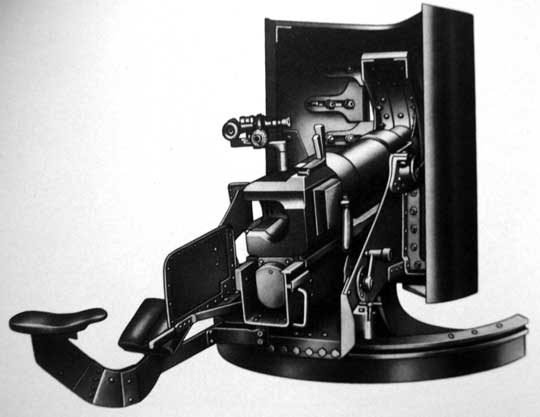
7,7 cm Sockel-Panzerwagengeschűtz gun, main armament of the Grosskampfagen super-heavy tank
On June 28, 1917, the War Department placed an order for ten K-Wagens. The technical documentation was created at the Riebe-Kugellager-Werken plant in Berlin-Weissensee. There, at the latest in July 1918, the construction of the first two tanks began, which was interrupted by the end of the war (according to other sources, the construction of two prototypes was completed on September 12, 1918). Perhaps the assembly of wagons was interrupted a little earlier, since on October 23, 1918 it was reported that the K-Wagen was not in the interests of the Imperial Army, and therefore its production was not included in the plan for the construction of combat tracked vehicles (with the working name Großen Programm). After the signing of the Treaty of Versailles, both tanks that were at the plant were to be disposed of by the allied commission.
An analysis of the design documentation, photographs of manufactured models, and the only archival photo of the unfinished K-Wagen standing in the Riebe production workshop allows us to conclude that the initial tactical and technical requirements were only partially reflected in the vehicles. Many fundamental changes have taken place, ranging from replacing the original engines with more powerful ones, through strengthening the armament (from two to four guns and from four to seven machine guns) and ending with thickening of the armor. They led to an increase in the weight of the tank (up to about 150 tons) and unit cost (up to 600 marks per tank). However, the postulate of a modular structure designed to facilitate transportation was implemented; the tank consisted of at least four main elements - i.e. landing gear, fuselage and two engine nacelles (Erkern).
At this point, there is probably a source of information that the K-Wagen weighed "only" 120 tons. This mass was likely the result of multiplying the number of components by their maximum (and allowed by the specifications) weight.
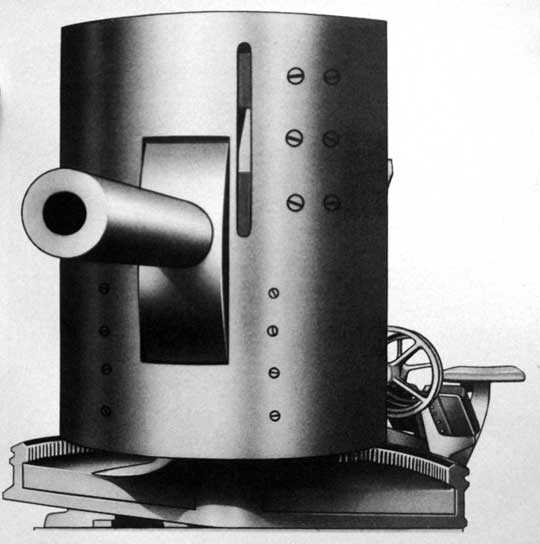
7,7 cm Sockel-Panzerwagengeschűtz gun, main armament of the Grosskampfagen super-heavy tank part 2
This separation made it easy to dismantle the car into parts (which was done with a crane) and load them into railway cars. Having reached the unloading station, the wagon had to be assembled again (also with the help of a crane) and sent into battle. So, although the method of transporting the K-Wagen theoretically seemed to have been solved, the question remains, what would its road to the front look like if it turned out that it would have to overcome, for example, ten kilometers in the field under its own power and in its own way?
Description of technology
According to the general design characteristics, the K-Wagen consisted of the following main elements: landing gear, fuselage and two engine nacelles.
The concept of building the undercarriage of the tank in the most general terms resembled that of the Mk. IV, commonly known as diamond-shaped. The main part of the caterpillar mover was thirty-seven carts. Each cart had a length of 78 cm and consisted of four wheels (two on each side), which moved in the grooves placed in the space between the armor plates that made up the car frame. A steel plate with teeth was welded to the outer (facing the ground) side of the carts, shock-absorbed by vertical springs (suspension), to which the working link of the caterpillar was attached (the connecting link was separated from the neighboring one). The carts were driven by two drive wheels located in the rear of the tank, but it is not known what the implementation of this process looked like from the technical side (kinematic link).
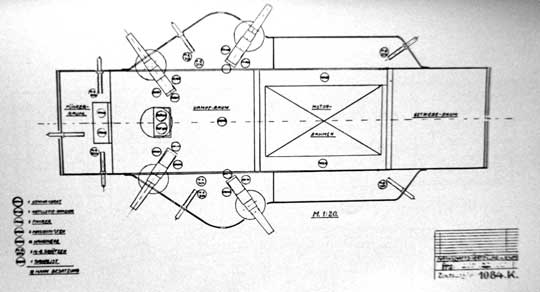
Schematic showing the division of the K-Wagen hull.
The body of the machine was divided into four compartments. In the front was the steering compartment with seats for two drivers and machine gun positions (see below). Next was the fighting compartment, which housed the main armament of the tank in the form of four 7,7-cm Sockel-Panzerwagengeschűtz guns, located in pairs in two engine nacelles mounted on the sides of the vehicle, one on each side. It is assumed that these guns were a fortified version of the widely used 7,7 cm FK 96, due to which they had a small, only 400 mm, return. Each gun was operated by three soldiers, and the ammunition inside was 200 rounds per gun. The tank also had seven machine guns, three of which were in front of the control compartment (with two soldiers) and four more in engine nacelles (two on each side; one, with two arrows, was installed between the guns, and the other at the end of the gondola, next to with engine bay). Approximately one third of the length of the fighting compartment (counting from the front) were the positions of two artillery observers, inspecting the surrounding area in search of targets from a special turret mounted on the ceiling. Behind them was the place of the commander, who supervised the work of the entire crew. In the compartment next in a row, two car engines were installed, which were controlled by two mechanics. There is no complete agreement in the literature on this subject as to what type and power these propulsors were. The most common information is that the K-Wagen had two Daimler aircraft engines with a capacity of 600 hp each. each. The last compartment (Getriebe-Raum) contained all the elements of the power transmission. The forehead of the hull was protected by 40 mm armor, which actually consisted of two 20 mm armor plates installed at a short distance from each other. The sides (and probably the stern) were covered with armor 30 mm thick, and the ceiling - 20 mm.
Summation
If you look at the experience of World War II, then German tanks weighing 100 tons or more turned out to be, to put it mildly, a misunderstanding. An example is the Mouse tank. Although well armored and heavily armed, but in terms of mobility and mobility, it was much inferior to lighter structures, and as a result, if it had not been immobilized by the enemy, it would certainly have been made by nature, because a swampy area or even an inconspicuous hill could be for him impossible transition. The complex design did not facilitate serial production or maintenance in the field, and the huge mass was a real test for logistics services, because transporting such a colossus, even for a short distance, required above-average resources. The too-thin hull roof meant that while the thick armor plates protecting the forehead, sides and turret theoretically offered long-range protection against most anti-tank gun rounds at the time, the vehicle was not immune from aerial fire that any rocket or flashbomb would posed a mortal threat to him.
Probably all of the above shortcomings of the Maus, which in fact were much more, would almost certainly bother K-Wagen if it managed to enter service (the modular design only partially or even seemed to solve the problem of transporting the machine). To destroy him, he would not even have to turn on aviation (in fact, it would pose an insignificant threat to him, because during the Great War it was not possible to build an aircraft capable of effectively hitting small-sized point targets), because the armor at his disposal was so small that it could be eliminated with a field gun, and besides, it was of medium caliber. Thus, there are many indications that the K-Wagen will never prove successful on the battlefield, however, looking at it from the side of the history of the development of armored vehicles, it should be stated that it was certainly an interesting vehicle, representing an otherwise lightweight - not say - zero value of combat utility.